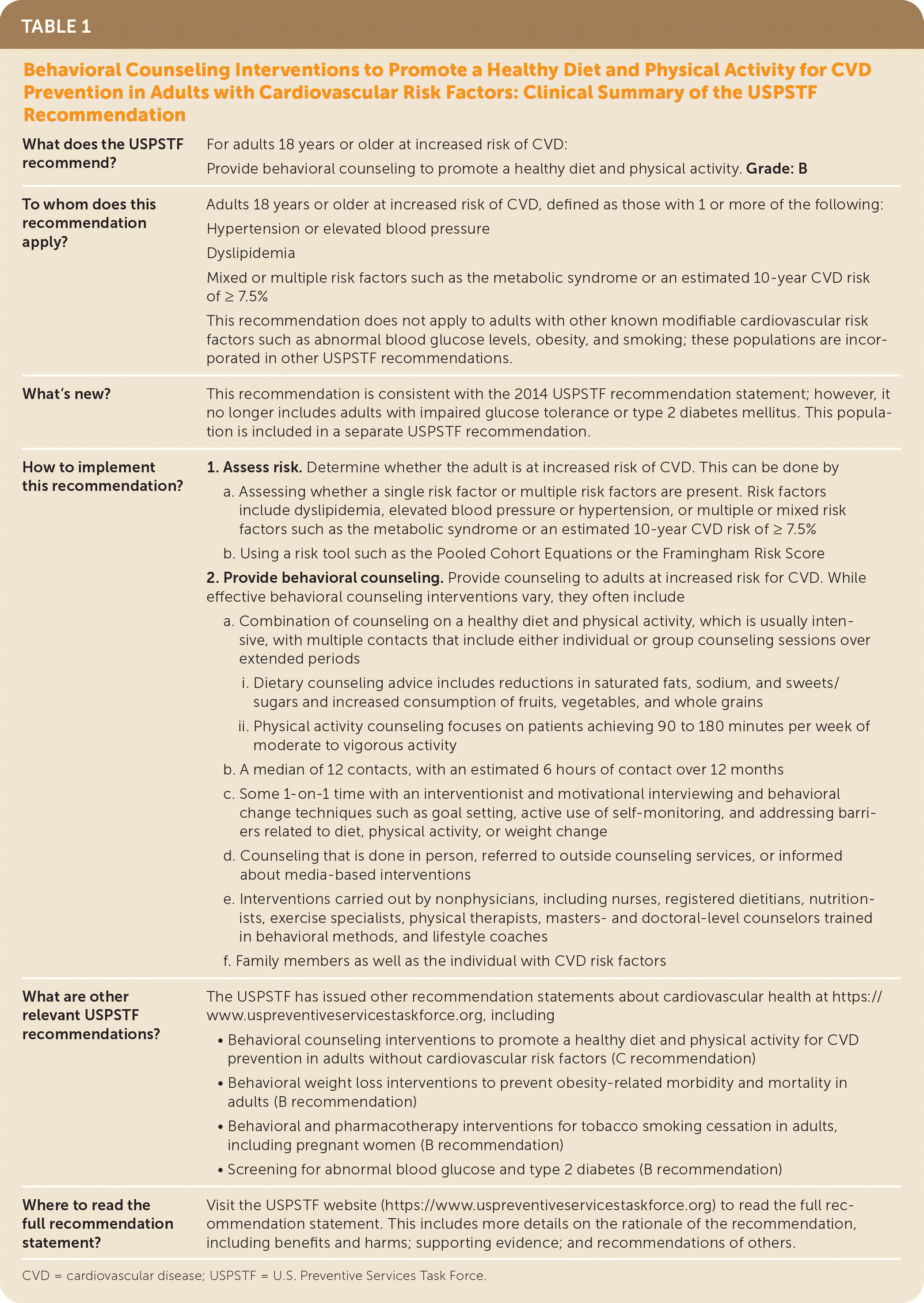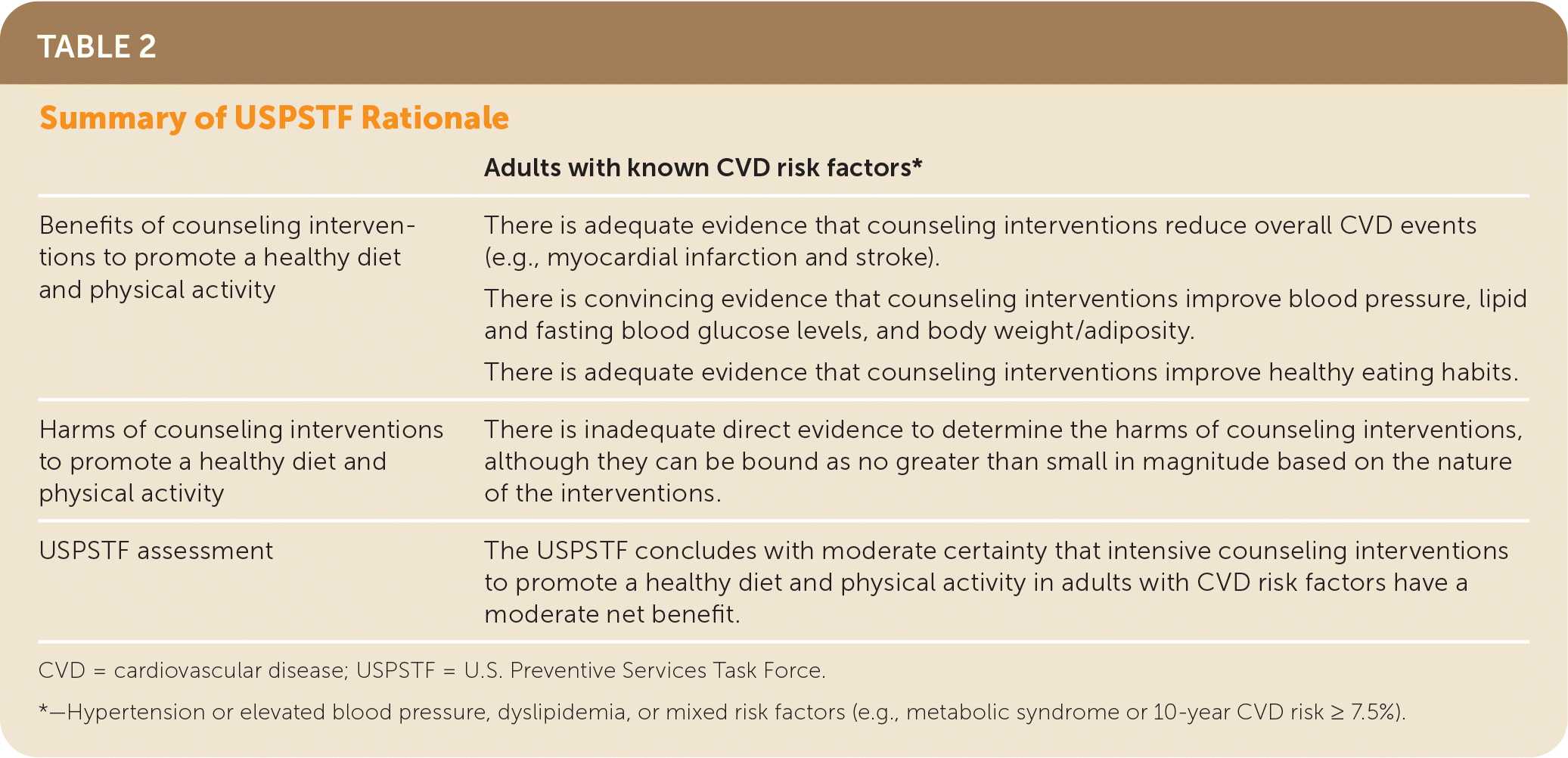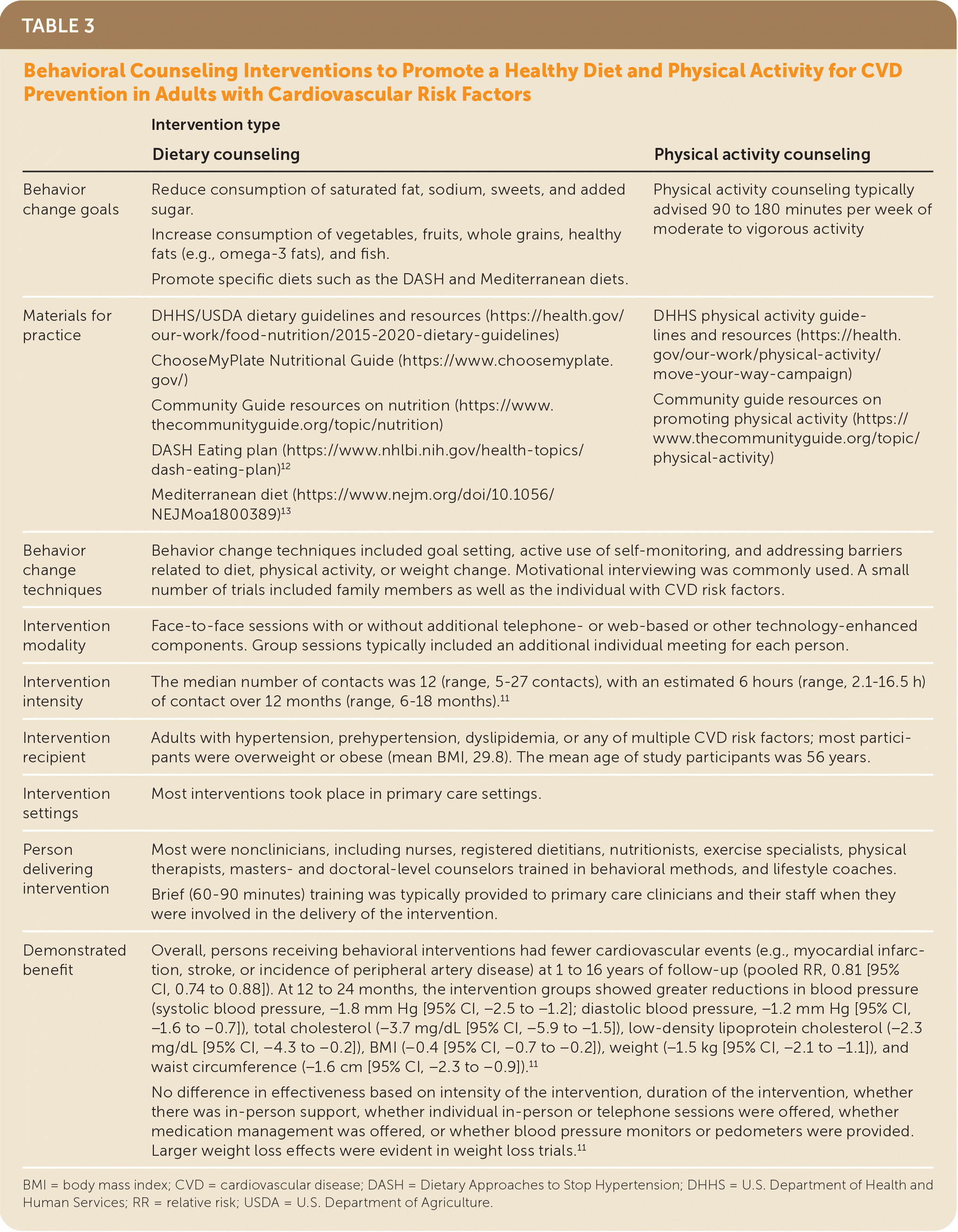
Am Fam Physician. 2021;103(6):366-370
Related Putting Prevention Into Practice: Healthy Diet and Physical Activity for Cardiovascular Disease Prevention in Adults with Cardiovascular Risk Factors
As published by the USPSTF.
Summary of Recommendation and Evidence
The USPSTF recommends offering or referring adults with cardiovascular disease (CVD) risk factors to behavioral counseling interventions to promote a healthy diet and physical activity (Table 1). B recommendation.

| What does the USPSTF recommend? | For adults 18 years or older at increased risk of CVD: Provide behavioral counseling to promote a healthy diet and physical activity. Grade: B |
| To whom does this recommendation apply? | Adults 18 years or older at increased risk of CVD, defined as those with 1 or more of the following: Hypertension or elevated blood pressure Dyslipidemia Mixed or multiple risk factors such as the metabolic syndrome or an estimated 10-year CVD risk of ≥ 7.5% This recommendation does not apply to adults with other known modifiable cardiovascular risk factors such as abnormal blood glucose levels, obesity, and smoking; these populations are incorporated in other USPSTF recommendations. |
| What's new? | This recommendation is consistent with the 2014 USPSTF recommendation statement; however, it no longer includes adults with impaired glucose tolerance or type 2 diabetes mellitus. This population is included in a separate USPSTF recommendation. |
| How to implement this recommendation? |
|
| What are other relevant USPSTF recommendations? | The USPSTF has issued other recommendation statements about cardiovascular health at https://www.uspreventiveservicestaskforce.org, including
|
| Where to read the full recommendation statement? | Visit the USPSTF website (https://www.uspreventiveservicestaskforce.org) to read the full recommendation statement. This includes more details on the rationale of the recommendation, including benefits and harms; supporting evidence; and recommendations of others. |
Importance
CVD is the leading cause of death in the United States.1 Known modifiable risk factors for CVD include smoking, being overweight or obese, diabetes mellitus, elevated blood pressure or hypertension, dyslipidemia, lack of physical activity, and unhealthy diet. Adults who adhere to national guidelines for a healthy diet2 and physical activity3 have lower cardiovascular morbidity and mortality than those who do not. All persons, regardless of their CVD risk status, can gain health benefits from healthy eating behaviors and appropriate physical activity.
USPSTF Assessment of Magnitude of Net Benefit
The USPSTF concludes with moderate certainty that behavioral counseling interventions have a moderate net benefit on CVD risk in adults at increased risk for CVD.

| Adults with known CVD risk factors* | |
|---|---|
| Benefits of counseling interventions to promote a healthy diet and physical activity | There is adequate evidence that counseling interventions reduce overall CVD events (e.g., myocardial infarction and stroke). There is convincing evidence that counseling interventions improve blood pressure, lipid and fasting blood glucose levels, and body weight/adiposity. There is adequate evidence that counseling interventions improve healthy eating habits. |
| Harms of counseling interventions to promote a healthy diet and physical activity | There is inadequate direct evidence to determine the harms of counseling interventions, although they can be bound as no greater than small in magnitude based on the nature of the interventions. |
| USPSTF assessment | The USPSTF concludes with moderate certainty that intensive counseling interventions to promote a healthy diet and physical activity in adults with CVD risk factors have a moderate net benefit. |
Practice Considerations
PATIENT POPULATION UNDER CONSIDERATION
This recommendation applies to adults 18 years or older with known hypertension or elevated blood pressure, those with dyslipidemia, or those who have mixed or multiple risk factors such as metabolic syndrome or an estimated 10-year CVD risk of 7.5% or greater. Adults with other known modifiable cardiovascular risk factors such as abnormal blood glucose levels, obesity, and smoking are not included in this recommendation.5–7 Interventions to reduce CVD risk in those adults are covered in other USPSTF recommendations.
DEFINITIONS OF HEALTHY DIET AND PHYSICAL ACTIVITY
The term healthy diet is defined as a balance and variety of foods and beverages that assist an individual in achieving and maintaining a healthy weight, support health, and prevent disease. Dietary counseling to promote a healthy diet focuses on increasing consumption of fruits, vegetables, whole grains, fat-free or low-fat dairy, lean proteins, and oils and decreasing consumption of foods with high sodium levels, saturated or trans fats, and added sugars, as recommended by the U.S. Department of Agriculture and the U.S. Food and Drug Administration.1
Physical activity is broadly defined as any bodily activity that enhances or maintains overall health and physical fitness. The U.S. Department of Health and Human Services recommends that adults 18 years or older engage in at least 150 minutes of moderate-intensity or 75 minutes of vigorous-intensity aerobic physical activity per week in addition to engaging in strengthening activities at least twice per week.1,8
ASSESSMENT OF RISK
Cardiovascular risk can be characterized as the elevation of a single risk factor or multiple risk factors (e.g., metabolic syndrome). Cardiovascular risk can be estimated through the use of CVD risk tools such as the Pooled Cohort Equations and Framingham Risk Score.9,10 CVD risk factors covered in this recommendation include dyslipidemia, elevated blood pressure or hypertension, and multiple or mixed risk factors.
BEHAVIORAL COUNSELING INTERVENTIONS
Behavioral counseling interventions usually combine counseling on a healthy diet and physical activity and are usually intensive, with multiple contacts that include either individual or group counseling sessions over extended periods. Interventions usually involve a median of 12 contacts, with an estimated 6 hours of contact time over 6 to 18 months. Interventions typically involve some 1-on-1 time with an interventionist and include motivational interviewing and behavioral change techniques such as goal setting, problem solving, and self-monitoring. Primary care clinicians as well as a wide range of specially trained professionals, including nurses, registered dietitians, nutritionists, exercise specialists, physical therapists, masters- and doctoral-level counselors trained in behavioral methods, and lifestyle coaches, can deliver these interventions.
Common dietary counseling advice includes reductions in saturated fats, sodium, and sweets/sugars and increased consumption of fruits, vegetables, and whole grains. The Dietary Approaches to Stop Hypertension (DASH) diet, low-sodium diet, and the Mediterranean diet are commonly recommended. Physical activity counseling focuses on patients achieving 90 to 180 minutes per week of moderate to vigorous activity.11
IMPLEMENTATION
Primary care clinicians can deliver in-person behavioral counseling interventions, refer patients to behavioral counseling interventions in other settings, or inform patients about media-based interventions. For more information about risk assessment methods and behavioral counseling interventions, see the Additional Tools and Resources section and Table 3.11–13

| Intervention type | |||
|---|---|---|---|
| Dietary counseling | Physical activity counseling | ||
| Behavior change goals | Reduce consumption of saturated fat, sodium, sweets, and added sugar. Increase consumption of vegetables, fruits, whole grains, healthy fats (e.g., omega-3 fats), and fish. Promote specific diets such as the DASH and Mediterranean diets. | Physical activity counseling typically advised 90 to 180 minutes per week of moderate to vigorous activity | |
| Materials for practice | DHHS/USDA dietary guidelines and resources (https://health.gov/our-work/food-nutrition/2015-2020-dietary-guidelines) ChooseMyPlate Nutritional Guide (https://www.choosemyplate.gov/) Community Guide resources on nutrition (https://www.thecommunityguide.org/topic/nutrition) DASH Eating plan (https://www.nhlbi.nih.gov/health-topics/dash-eating-plan)12 Mediterranean diet (https://www.nejm.org/doi/10.1056/NEJMoa1800389)13 | DHHS physical activity guidelines and resources (https://health.gov/our-work/physical-activity/move-your-way-campaign) Community guide resources on promoting physical activity (https://www.thecommunityguide.org/topic/physical-activity) | |
| Behavior change techniques | Behavior change techniques included goal setting, active use of self-monitoring, and addressing barriers related to diet, physical activity, or weight change. Motivational interviewing was commonly used. A small number of trials included family members as well as the individual with CVD risk factors. | ||
| Intervention modality | Face-to-face sessions with or without additional telephone- or web-based or other technology-enhanced components. Group sessions typically included an additional individual meeting for each person. | ||
| Intervention intensity | The median number of contacts was 12 (range, 5–27 contacts), with an estimated 6 hours (range, 2.1–16.5 h) of contact over 12 months (range, 6–18 months).11 | ||
| Intervention recipient | Adults with hypertension, prehypertension, dyslipidemia, or any of multiple CVD risk factors; most participants were overweight or obese (mean BMI, 29.8). The mean age of study participants was 56 years. | ||
| Intervention settings | Most interventions took place in primary care settings. | ||
| Person delivering intervention | Most were nonclinicians, including nurses, registered dietitians, nutritionists, exercise specialists, physical therapists, masters- and doctoral-level counselors trained in behavioral methods, and lifestyle coaches. Brief (60–90 minutes) training was typically provided to primary care clinicians and their staff when they were involved in the delivery of the intervention. | ||
| Demonstrated benefit | Overall, persons receiving behavioral interventions had fewer cardiovascular events (e.g., myocardial infarction, stroke, or incidence of peripheral artery disease) at 1 to 16 years of follow-up (pooled RR, 0.81 [95% CI, 0.74 to 0.88]). At 12 to 24 months, the intervention groups showed greater reductions in blood pressure (systolic blood pressure, −1.8 mm Hg [95% CI, −2.5 to −1.2]; diastolic blood pressure, −1.2 mm Hg [95% CI, −1.6 to −0.7]), total cholesterol (−3.7 mg/dL [95% CI, −5.9 to −1.5]), low-density lipoprotein cholesterol (−2.3 mg/dL [95% CI, −4.3 to −0.2]), BMI (−0.4 [95% CI, −0.7 to −0.2]), weight (−1.5 kg [95% CI, −2.1 to −1.1]), and waist circumference (−1.6 cm [95% CI, −2.3 to −0.9]).11 No difference in effectiveness based on intensity of the intervention, duration of the intervention, whether there was in-person support, whether individual in-person or telephone sessions were offered, whether medication management was offered, or whether blood pressure monitors or pedometers were provided. Larger weight loss effects were evident in weight loss trials.11 | ||
ADDITIONAL TOOLS AND RESOURCES
The Community Preventive Ser vices Task Force recommends several community-based interventions to promote a healthy diet (https://www.thecommunityguide.org/topic/nutrition) and physical activity (https://www.thecommunityguide.org/topic/physical-activity), including community-wide campaigns, social support interventions, school-based interventions, and environmental and policy approaches.
The U.S. Department of Health and Human Services and the U.S. Department of Agriculture have developed dietary (https://health.gov/our-work/food-nutrition/2015-2020-dietary-guidelines) and physical activity (https://health.gov/our-work/physical-activity/current-guidelines) guidelines. Resources for clinicians can be found at https://health.gov/dietaryguidelines/2015/resources and https://health.gov/our-work/physical-activity/move-your-way-campaign.
OTHER RELATED USPSTF RECOMMENDATIONS
The USPSTF has several recommendations related to behavioral counseling interventions and the prevention of CVD. These include recommendations on behavioral counseling to promote a healthy diet and physical activity for CVD prevention in adults without cardiovascular risk factors (C recommendation)14; behavioral weight loss interventions to prevent obesity-related morbidity and mortality in adults (B recommendation)6; behavioral and pharmacotherapy interventions for tobacco smoking cessation in adults, including pregnant women (B recommendation)7; and screening for abnormal blood glucose levels and type 2 diabetes (B recommendation).5
Editor's Note: Driven by systemic racism, disparities in access to healthy food and safe spaces for physical activity contribute to the disproportionate burden of CVD among Black adults in the United States.1 In a recent commentary, the USPSTF acknowledged that “the potential life-saving benefits of recommended [preventive] services are not equitably available to Black, Indigenous, and Hispanic/Latino people.”2 In response, the USPSTF has committed to advancing its methods to better understand systemic racism's adverse consequences; identifying inclusive, evidence-based interventions to mitigate these consequences; and collaborating with other medical, policy, and patient advocacy groups to reduce and reverse the influence of systemic racism on preventable disease outcomes.2 American Family Physician is pleased to partner with the Task Force in antiracist efforts to promote health equity for all patients and communities.—Kenny Lin, MD, MPH, Deputy Editor
1. Churchwell K, Elkind MSV, Benjamin RM, et al. Call to action: structural racism as a fundamental driver of health disparities: a Presidential Advisory from the American Heart Association. Circulation. 2020;142(24):e454–e468.
2. Doubeni CA, Simon M, Krist AH. Addressing systemic racism through clinical preventive service recommendations from the US Preventive Services Task Force. JAMA. 2021;325(7):627–628.
This recommendation statement was first published in JAMA. 2020;324(20):2069–2075.
The “Update of Previous USPSTF Recommendation,” “Supporting Evidence,” “Research Needs and Gaps,” and “Recommendations of Others” sections of this recommendation statement are available at https://www.uspreventiveservicestaskforce.org/uspstf/recommendation/healthy-diet-and-physical-activity-counseling-adults-with-high-risk-of-cvd.
The USPSTF recommendations are independent of the U.S. government. They do not represent the views of the Agency for Healthcare Research and Quality, the U.S. Department of Health and Human Services, or the U.S. Public Health Service.
This summary is one in a series excerpted from the Recommendation Statements released by the USPSTF. These statements address preventive health services for use in primary care clinical settings, including screening tests, counseling, and preventive medications.
The complete version of this statement, including supporting scientific evidence, evidence tables, grading system, members of the USPSTF at the time this recommendation was finalized, and references, is available on the USPSTF website at https://www.uspreventiveservicestaskforce.org/.
